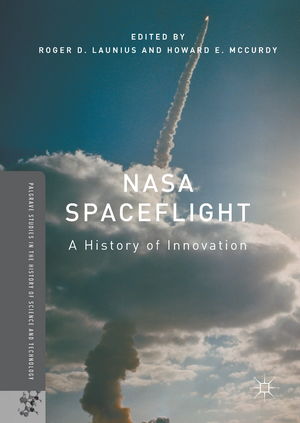NASA Spaceflight: A History of Innovation: Palgrave Studies in the History of Science and Technology
Editat de Roger D. Launius, Howard E. McCurdyen Limba Engleză Hardback – 23 oct 2017
Toate formatele și edițiile
| Toate formatele și edițiile | Preț | Express |
|---|---|---|
| Paperback (1) | 693.86 lei 38-45 zile | |
| Springer International Publishing – 23 aug 2018 | 693.86 lei 38-45 zile | |
| Hardback (1) | 795.83 lei 6-8 săpt. | |
| Springer International Publishing – 23 oct 2017 | 795.83 lei 6-8 săpt. |
Din seria Palgrave Studies in the History of Science and Technology
-
 Preț: 352.16 lei
Preț: 352.16 lei -
 Preț: 223.88 lei
Preț: 223.88 lei -
 Preț: 491.21 lei
Preț: 491.21 lei - 18%
 Preț: 783.81 lei
Preț: 783.81 lei - 15%
 Preț: 645.93 lei
Preț: 645.93 lei - 18%
 Preț: 734.09 lei
Preț: 734.09 lei - 15%
 Preț: 698.94 lei
Preț: 698.94 lei - 15%
 Preț: 640.37 lei
Preț: 640.37 lei - 15%
 Preț: 695.01 lei
Preț: 695.01 lei -
 Preț: 385.25 lei
Preț: 385.25 lei -
 Preț: 323.28 lei
Preț: 323.28 lei -
 Preț: 332.33 lei
Preț: 332.33 lei -
 Preț: 389.11 lei
Preț: 389.11 lei - 18%
 Preț: 786.98 lei
Preț: 786.98 lei -
 Preț: 383.93 lei
Preț: 383.93 lei - 18%
 Preț: 772.30 lei
Preț: 772.30 lei - 18%
 Preț: 948.16 lei
Preț: 948.16 lei - 18%
 Preț: 732.52 lei
Preț: 732.52 lei -
 Preț: 383.93 lei
Preț: 383.93 lei -
 Preț: 418.07 lei
Preț: 418.07 lei - 18%
 Preț: 731.91 lei
Preț: 731.91 lei - 18%
 Preț: 727.18 lei
Preț: 727.18 lei -
 Preț: 391.02 lei
Preț: 391.02 lei - 18%
 Preț: 729.68 lei
Preț: 729.68 lei -
 Preț: 398.35 lei
Preț: 398.35 lei - 15%
 Preț: 645.79 lei
Preț: 645.79 lei -
 Preț: 420.97 lei
Preț: 420.97 lei - 15%
 Preț: 582.80 lei
Preț: 582.80 lei -
 Preț: 213.58 lei
Preț: 213.58 lei - 18%
 Preț: 785.11 lei
Preț: 785.11 lei -
 Preț: 385.84 lei
Preț: 385.84 lei -
 Preț: 388.52 lei
Preț: 388.52 lei -
 Preț: 417.68 lei
Preț: 417.68 lei -
 Preț: 385.84 lei
Preț: 385.84 lei
Preț: 795.83 lei
Preț vechi: 970.52 lei
-18% Nou
Puncte Express: 1194
Preț estimativ în valută:
152.28€ • 158.99$ • 126.03£
152.28€ • 158.99$ • 126.03£
Carte tipărită la comandă
Livrare economică 04-18 aprilie
Preluare comenzi: 021 569.72.76
Specificații
ISBN-13: 9783319601120
ISBN-10: 3319601121
Pagini: 402
Ilustrații: XXIII, 402 p. 41 illus., 33 illus. in color.
Dimensiuni: 148 x 210 mm
Greutate: 0.84 kg
Ediția:1st ed. 2018
Editura: Springer International Publishing
Colecția Palgrave Macmillan
Seria Palgrave Studies in the History of Science and Technology
Locul publicării:Cham, Switzerland
ISBN-10: 3319601121
Pagini: 402
Ilustrații: XXIII, 402 p. 41 illus., 33 illus. in color.
Dimensiuni: 148 x 210 mm
Greutate: 0.84 kg
Ediția:1st ed. 2018
Editura: Springer International Publishing
Colecția Palgrave Macmillan
Seria Palgrave Studies in the History of Science and Technology
Locul publicării:Cham, Switzerland
Cuprins
1. Introduction: Partnerships for Innovation.- 2. The Origins and Flagship Project of NASA's International Program—The Ariel Case Study.- 3. Global Instantaneous Telecommunications and the Development of Satellite Technology.- 4. The Other Side of Moore's Law—The Apollo Guidance Computer, the Integrated Circuit, and the Mircoelectronics Revolution, 1962–1975.- 5. NASA's Mission Control Center—The Space Program's Capitol as Innovative Capital.- 6. Lessons of Landsat—From Experimental Program to Commercial Land Imaging, 1969–1989.- 7. Selling the Space Shuttle—Early Developments.- 8. Something Borrowed, Something Blue—Re-purposing NASA's Spacecraft.- 9. Encouraging New Space Firms.- 10. The Discovery Program—Competition, Innovation, and Risk in Planetary Exploration.- 11. Partnerships for Innovation—The X-33/VentureStar.- 12. Microgravity, Macro Investment—Overcoming International Space Station Utilization Challenges through Managerial Innovation.- 12. NASA, Industry, and the CommercialCrew Development Program—The Politics of Partnership.- 13. Conclusion—What Matters?
Notă biografică
Roger D. Launius has written or edited more than thirty books on aerospace history, most recently Historical Analogs for the Stimulation of Space Commerce (2014), and Space Shuttle Legacy: How We Did It and What We Learned (2013).
Howard E. McCurdy is Professor in the School of Public Affairs at American University, USA. He is the author of numerous works on the national space program, including Inside NASA (1993), Faster, Better, Cheaper (2001), and Space and the American Imagination (rev. ed. 2011).
Textul de pe ultima copertă
This book presents the first comprehensive history of innovation at NASA, bringing together experts in the field to illuminate how public-private and international partnerships have fueled new ways of exploring space since the beginning of space travel itself. Twelve case studies trace the messy, risky history of such partnerships, exploring the role of AT&T in the early development of satellite technology, the connections between the Apollo program and Silicon Valley, the rise of SpaceX, and more. Some of these projects have succeeded, and some have failed; all have challenged conventional methods of doing the public’s business in space. Together, these essays offer new insights into how innovation happens, with invaluable lessons for policymakers, investors, economists, and members of the space community.
Caracteristici
Provides the first-ever comprehensive history of NASA innovation Features leading experts on aerospace history, the history of technology, and space policy Offers numerous case studies showing how NASA has used partnerships, competition, and cost-sharing to encourage innovation and restrain costs Includes supplementary material: sn.pub/extras
